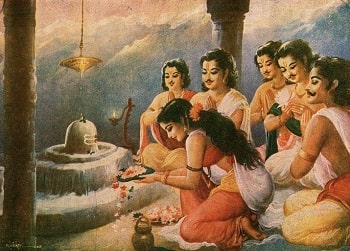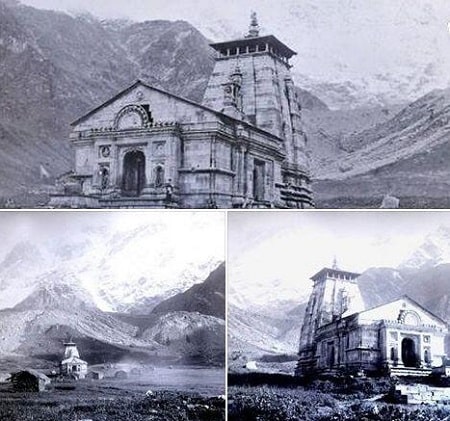The exact date of construction of Kedarnath Dham still remains a mystery since it cannot be traced to an exact date. However, there are numerous mentions of Kedarnath Dham in various holy Hindu books but none have mentioned the exact date of its creation. One of the most popular related legends to the origin of Kedarnath temple is:
The Pandava Story
 After having done with the Kurukshetra war and following the advice by the great sage Vyas, the Pandava brothers decided to leave and lookout for Lord Shiva. They did so since they thought that they needed to ask for forgiveness from the Lord himself. The Pandavas accompanied by Draupadi set out to the Himalayas after the war in search of Lord Shiva. Lord Shiva took the form of a bull in Guptkashi in an attempt to hide from them since the lord did not want to grant them forgiveness. Bheem then spotted the lord and that very moment he started sinking inside the ground where the lord was standing. Bheem held on to the tail of the bull in an attempt to stop him and ask him for forgiveness. Currently, there are temples (Panch Kedar) made on the place where the hands, face, hump and the legs of the bull came out. The lord was happy with their efforts and decided to grant them with forgiveness. Out of respect, the Pandava brothers established the temple of Kedarnath.
After having done with the Kurukshetra war and following the advice by the great sage Vyas, the Pandava brothers decided to leave and lookout for Lord Shiva. They did so since they thought that they needed to ask for forgiveness from the Lord himself. The Pandavas accompanied by Draupadi set out to the Himalayas after the war in search of Lord Shiva. Lord Shiva took the form of a bull in Guptkashi in an attempt to hide from them since the lord did not want to grant them forgiveness. Bheem then spotted the lord and that very moment he started sinking inside the ground where the lord was standing. Bheem held on to the tail of the bull in an attempt to stop him and ask him for forgiveness. Currently, there are temples (Panch Kedar) made on the place where the hands, face, hump and the legs of the bull came out. The lord was happy with their efforts and decided to grant them with forgiveness. Out of respect, the Pandava brothers established the temple of Kedarnath.
Historical Account
 The historical account of Kedarnath Dham can also be dated to 8th century BCE to the great sage and philosopher Adi Shankaracharya. Adi Shankara is credited with the revival of Hinduism in India after the dark ages of religion which had happened due to numerous invasions by various different communities of tribes and other foreign invaders. Adi Shankara wanted to revive the feeling of Hinduism amongst the citizens of India and he did so by travelling across the length and breadth of the nation while simultaneously establishing Matths, shrines and temples. When Adi Shankara reached Kedarnath he decided to reestablish it as a pilgrimage site along with Badrinath, Gangotri and Yamunotri. The temple of Kedarnath was already present there but Adi Shankara worked on making it ready for the pilgrims and spent a majority part of his lifetime there. He was successful in attracting other sadhus, devotees and pilgrims who also wanted to experience the grandness of the lord. To mark the contributions made by Adi Shankara a Samadhi was constructed right behind the main temple entrance since it was right there where he took his last breath. It is said that Adi Shankara travelled all over India but this was the place that he chose to spend his final days.
The historical account of Kedarnath Dham can also be dated to 8th century BCE to the great sage and philosopher Adi Shankaracharya. Adi Shankara is credited with the revival of Hinduism in India after the dark ages of religion which had happened due to numerous invasions by various different communities of tribes and other foreign invaders. Adi Shankara wanted to revive the feeling of Hinduism amongst the citizens of India and he did so by travelling across the length and breadth of the nation while simultaneously establishing Matths, shrines and temples. When Adi Shankara reached Kedarnath he decided to reestablish it as a pilgrimage site along with Badrinath, Gangotri and Yamunotri. The temple of Kedarnath was already present there but Adi Shankara worked on making it ready for the pilgrims and spent a majority part of his lifetime there. He was successful in attracting other sadhus, devotees and pilgrims who also wanted to experience the grandness of the lord. To mark the contributions made by Adi Shankara a Samadhi was constructed right behind the main temple entrance since it was right there where he took his last breath. It is said that Adi Shankara travelled all over India but this was the place that he chose to spend his final days.
Scientific Revelation
Although the exact date of the construction of Kedarnath temple remains a mystery, scientific evidences there have revealed that this place was constructed almost 3,000 years back during the time of Mahabharat. The temple is also said to have been completely covered inside ice for 400 years. In fact, research on the walls of the temple structure also reveals that the temple and the entire district of Rudraprayag was under snow during a mini ice age that took place here and lasted for 400 years. The miraculous fact about this is that no matter what the weather, the temple remained standing tall. Although covered inside ice, it did not experience any sort of damages or any sort of harm to the overall temple structure. This tells the fact that whoever had constructed the temple had kept in mind that the region is prone to harsh climatic conditions and the temple should not be damaged under any circumstances. Till Present day the temple structure remains standing tall and majestic.
Literary Mentions
Some literary mention in the holy Hindu books are:
- Mahabharat – although the account of Kurukshetra war does not give any deep information regarding Kedarnath Dham but it is known that the Pandava brothers along with Draupadi had visited Kedarnath and had also established the Panch Kedar Yatra.
- Skand Puran – dated to be composed between 7th to 8th century, the book mentions about a place called ‘Kedara’ where Lord Shiva is said to have released the holy River of Ganga from his matted hair.
Suggested Tours



 Call
Call WhatsApp
WhatsApp Enquiry
Enquiry